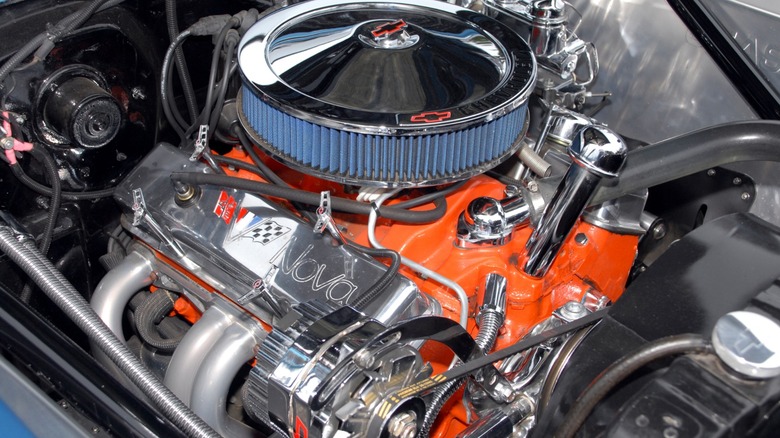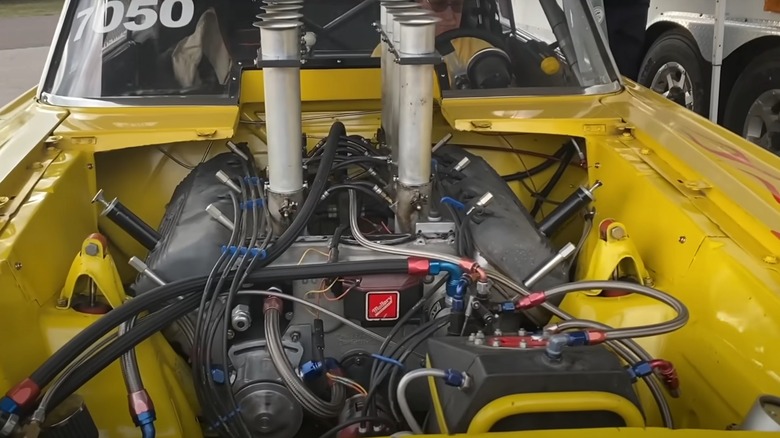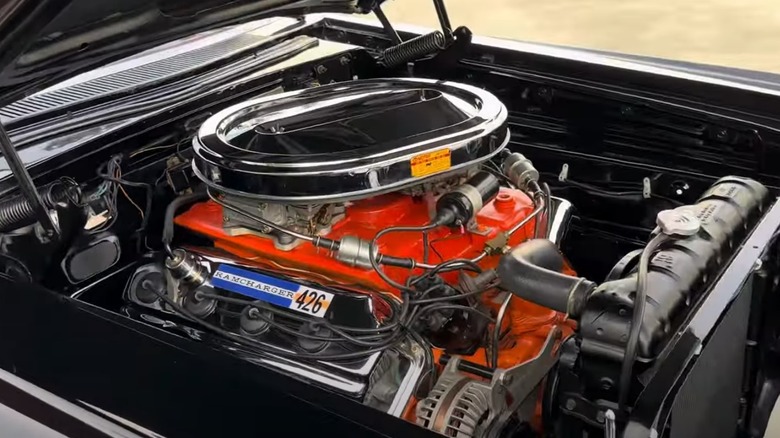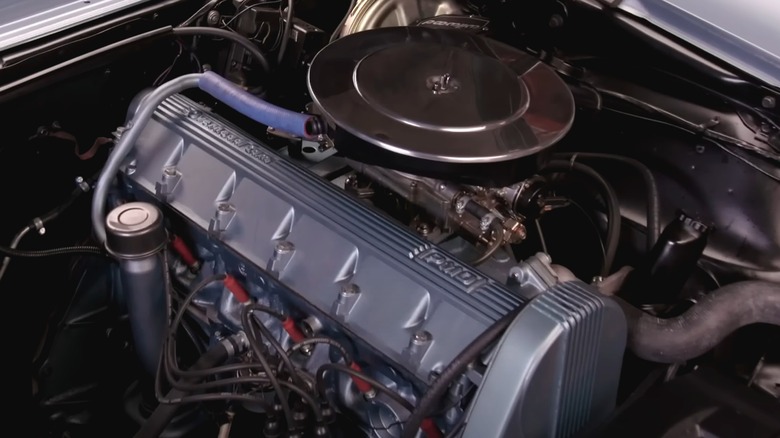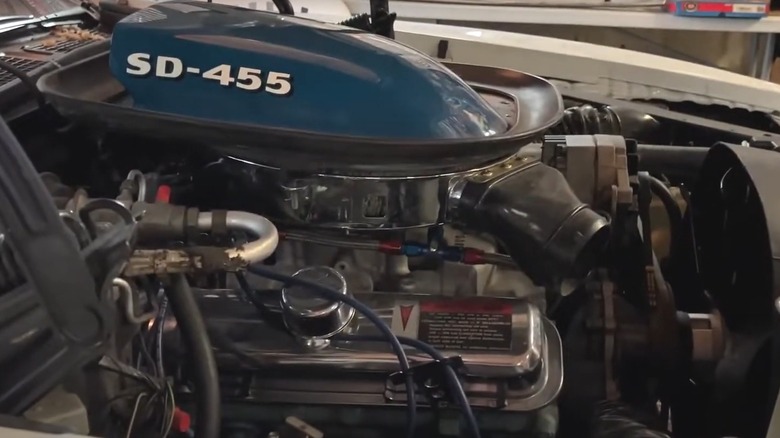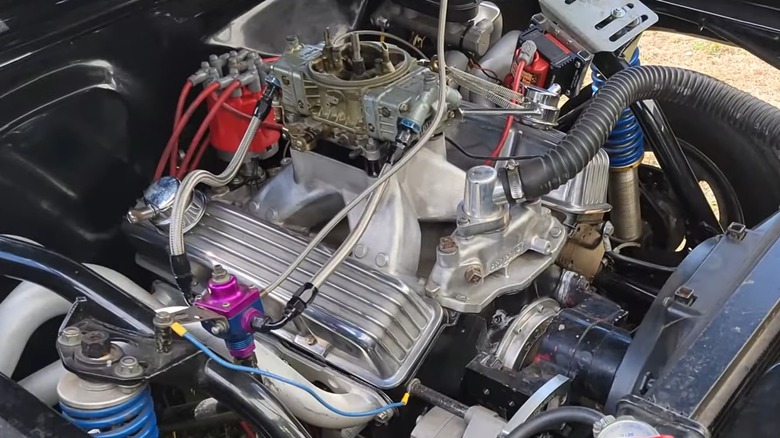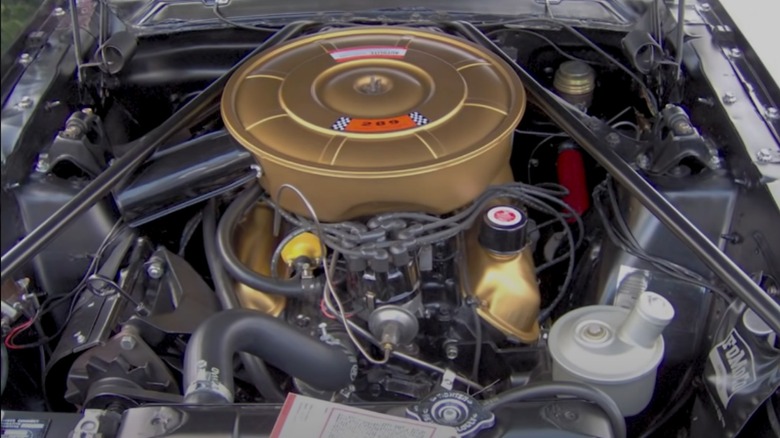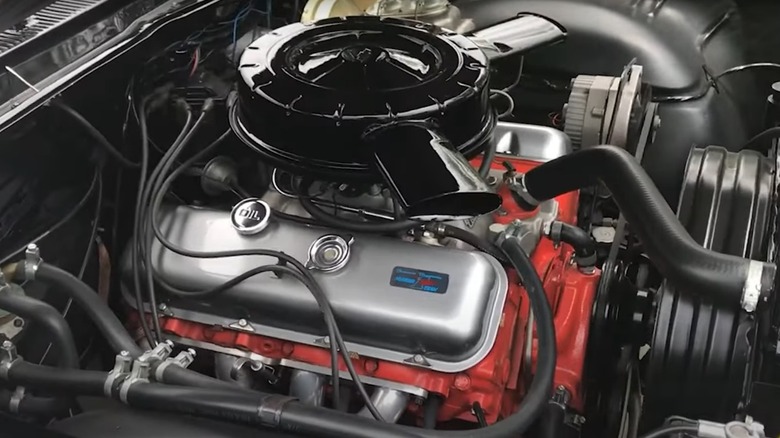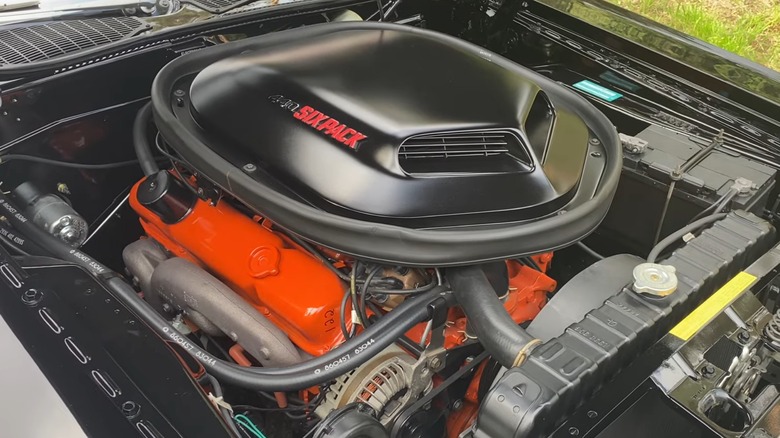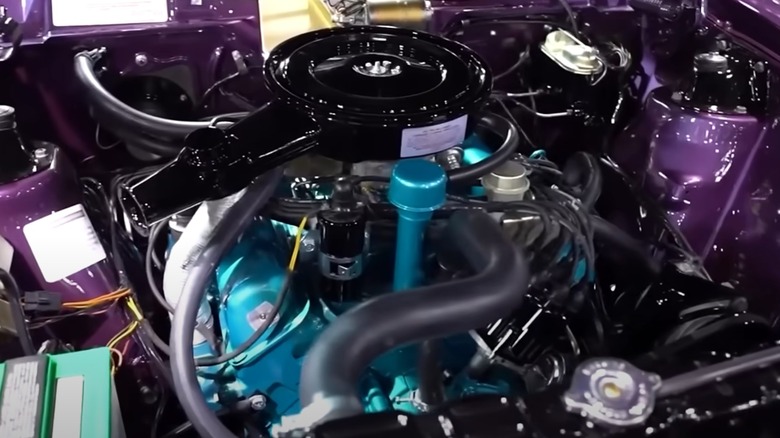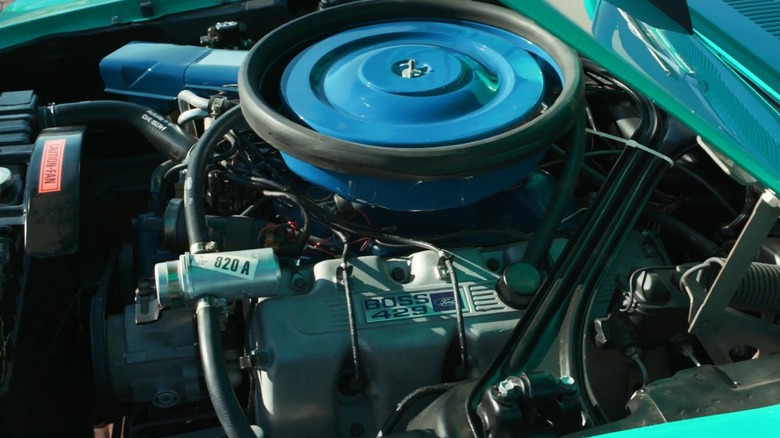10 Legendary Engines From Detroit's Golden Age
The history of the American automotive industry is woven throughout the country, with headquarters and factories located in many cities, but Detroit is its undisputed center, no matter how far its threads reach. When automakers punch ahead with innovation and reap the rewards of producing exceptional products, so does the city of Detroit and its residents. And while Detroit and the auto industry may be on relatively solid footing right now, many might argue its best days have already passed.
You will find some disagreement about exactly when Detroit enjoyed its best days. The general consensus of when its Golden Age occurred seems to be the period after the post-war boom through to the enactment of the Clean Air Act precipitating the general decline of horsepower. From roughly the mid '50s to the early '70s, Detroit presented us with what felt like endless innovation in engineering and design, and debuted what have since become iconic models of the industry. And it was in this time before engineers were forced to cope with pollution controls and efficiency that companies gave us those legendary engines we love to see in classic cars. Here are 10 of them.
Ford Cammer
When Ford released its Modular 4.6-liter overhead-cam V8 engine, it was a coup for the company as the first mass-produced American V8 with an overhead camshaft. However, this wasn't Ford's first attempt at removing the cam from the block. Its first V8 built in this configuration was never set for regular production, but it powered some of the fastest Fords of its day.
The Ford Cammer derives its nickname from its single overhead cam design. It is a 427 cubic-inch V8 built upon Ford's FE engine design introduced in 1958. Engineers developed custom heads each with a single camshaft driving two valves-per-cylinder in hemispherical combustion chambers — the elimination of pushrods allowed for longer and straighter intake ports. With the enormous size of the engine, a double timing chain 7 feet long drove the camshafts. Completed from idea to running engine in 90 days, the Cammer's output reached 616 hp with a single four-barrel carburetor, and 657 hp with dual carbs.
NASCAR defeats by Chrysler cars around 1964 with the 426 Hemi V8 precipitated the Cammer's development. Ford lobbied for rule changes for its new Hemi fighter V8, but was rebuffed. After NASCAR eventually relented and allowed it with several restrictions, Ford refused. However, the Cammer gained popularity in drag racing, particularly after a gear drive replaced the lengthy chain, becoming one of the most legendary engines in NHRA history.
Chrysler 426 Hemi
Chrysler's popular Hemi engines derive their name from the shape of their combustion chambers. To increase efficiency and power, they use a dome (or hemispherical) shape that helps to burn more of the fuel more rapidly, increasing power and efficiency. The trade-off of this type of engine is that the heads take up significantly more space, making the engines much larger overall. Chrysler first built engines with this feature in 1951 when it introduced its FirePower V8.
The basis for Chrysler's legendary 426 Hemi originated in the existing RB-series Max Wedge engine, producing up to 425 horsepower in the early 1960s. Looking for a way to raise its output, engineers looked to the brand's earlier V8 engine technology and adapted it to the existing big block engine, giving way to a new engine simply called the 426 Hemi. Originally built for use only in NASCAR racing, Chrysler found itself butting up against new regulations booting the engine from racing in 1965 due to a lack of production versions of the engine at dealerships. Eager to get it back on the track, Chrysler announced that its 1966 intermediate cars could be ordered with a detuned version of the engine called the "Street 426" Hemi.
Although it was pricey, the Street Hemi was chosen by many buyers eager to trounce competitors in street races. Production ended in 1971 as Detroit's Golden Era came to a close, but it remains a highly valuable option on surviving cars today.
Pontiac Sprint 6 OHC
Although V8s tend to sit atop a high pedestal in conversations about past triumphs of Detroit engineering, domestic automakers have a long and proud history of innovation through a range of engine sizes and configurations. Hudson's Twin H-Power inline-six dominated NASCAR in the '50s, and the Chevrolet Corvair's boxer six-cylinder was one of the first production turbocharged engines, releasing in 1962. A few years later, Pontiac released one of its best engines with the Sprint 6 OHC, offered from 1966 to 1969.
Under the tutelage of John Z. DeLorean, Pontiac introduced several products that anticipated consumer demands to deliver products they wanted to buy. His fingerprints were all over the utterly successful GTO and the launch of the new Firebird. He also oversaw the development and introduction of the Sprint 6, the first American-built engine with a belt-driven overhead camshaft.
OHC engines were common in Europe but cost prevented most American companies from pursuing them. Using a belt instead of chains or gears made it much cheaper to produce while retaining the advantages of the more sophisticated configuration. Unfortunately, even though the Sprint proved to be a great engine producing up to 230 hp with a Quadra-jet carburetor installed, the era called for V8s and buyers overlooked the innovative cammer engine. It was withdrawn after the 1969 model year and overhead cams would not gain widespread usage at GM for a generation.
Pontiac 455 Super Duty
In 1970, three GM divisions offered cars with a 455 V8. But while technology sharing was common within GM, these three engines were unique to each division: the Buick 455, Oldsmobile 455, and Pontiac 455 shared no internal parts or designs. Power output from all three was similar, but the Pontiac 455 outlasted them all. It served as the top engine option for a range of Pontiac models in the beginning, and lasted all the way through 1974 in the Trans Am, making it the last of the big-block muscle cars.
The Super Duty 455 came a bit later than some other big American V8 engines, but it came correct, powering Pontiac two-door A-bodies and Firebirds with up to 335 horsepower and a ton of torque. Pontiac even continued offering the engine through 1974 while maintaining ample power output, employing a little subterfuge to get around the newly established EPA.
During initial emissions testing by government officials, the Super Duty 455 was equipped with Transmission Controlled Spark working with the EGR to control emissions per the regulations. Pontiac created its system to work to pass the test for the duration of the test and return to an unrestricted state after a much longer time, boosting power but also emissions. The EPA eventually caught on and forced compliance. But we have to give it to Pontiac for being a bit cheeky with its 455 and trying to keep it 100 while it could.
Small-block Chevy V8
In any discussion of power from the streets of Detroit, nothing compares to the longevity and legend of Chevrolet's small-block V8. For six decades, it powered millions of cars and trucks coming out of not only Chevrolet factories, but also other GM divisions.
When the Corvette debuted in 1953, Chevy had no V8 engine for its new sports car and settled on the robust Stovebolt inline-six Blue Flame engine. Just a couple of years later in 1955, the first V8 from Chevrolet was introduced, ushering in a new era of cheap and reliable horsepower. Many of the innovations that came with that 1955 engine proved so effective that few changes to the fundamentals of the block were needed, even as technology such as fuel injection arrived to make it even more efficient and powerful.
Initially displacing 265 cubic inches, larger variants were introduced over the years, including a 327 and 302. And then the 350 debuted in 1969, setting the standard for an American V8 that served for high-performance applications as well as workhorse applications in trucks. After a decline in power through the '70s, the 1985 Tuned Port Injection Corvette 350 signaled the return of the small-block Chevy as a performance leader. It lasted unchanged until the LT1 Gen II debuted in 1992 as a revised small-block V8 with some of the original design intact. Even today, the Chevy 350 remains one of the most popular classic V8s ever made.
Ford Windsor 302 V8
Named for the Canadian city in which it was initially built, the Ford Windsor 302 V8 was a staple engine used across a range of trucks and cars tuned for power, torque, or efficiency for more than a generation. It can still be found powering millions of cars on the road today.
Introduced for the 1962 model year in the Ford Fairlane and Mercury Meteor, the new Ford small-block V8, dubbed Challenger, sought to improve Ford capabilities against competitors with better engine designs. Originally just 221 cubic inches, it was raised to 260 halfway through the year. It then received a big boost as the V8 option for the then-new 1964 ½ Mustang, which could be ordered with a 289 V8. That would then be increased to 302, which Ford continued using through the new millennium alongside a larger 351. An exception came from 1980 to 1980, when Ford reduced the size to a meager 255 cubic inches and a new low for power.
With the new Fox-body Mustang introduced in 1979, Ford began its climb out of the doldrums. It raised displacement back to 302 in 1982 and rebadged its cars with its metric denomination, 5.0. This was followed by the 5.0 High Output engine featuring sequential multi-port fuel injection and the return of high power Mustangs. The 5.0 reigned supreme in the '90s, and even as Ford shifted to its new Modular engine family, it lived on in the Explorer until 2001.
Chevrolet L88 427 V8
The Chevrolet Corvette was built with a winning formula from the start. It used a sports car chassis built for great handling and set a fiberglass body over the top to keep weight down to a minimum. Even with the lower power of early models, it made for quick driving in the straights and fun cornering through the turns. Chevrolet's small-block V8 opened the car up for an even better driving experience, but it moved to another level altogether when Chevrolet offered the Corvette with a huge 427 V8.
In 1966 the Corvette was offered with a 427, the L72 with iron block and heads, for the first time, raising its available power to 425 hp and making it incredibly potent on the street or the track. However, another big-block was added to the roster the following year.
The L88 427 featured aluminum heads with larger intake ports and stamped steel rocker arms, plus additional valve springs for engine speeds above 7,000 rpm. It also received an aggressive camshaft with fuel fed by an 850 Holley four-barrel carburetor, the largest ever offered on a production GM model.
Official output rating of the L88 was 430 hp, but rumors suggest it was under-rated, with an actual output over 500 hp. Considering the L73 was rated at 435 horsepower for $1,000 less, this is totally plausible. This very expensive option only found its way into a handful of Corvettes, but they would have been fierce competition on the track.
Chrysler 440 Six Pack
Chrysler's big-block Hemis rank highly on any list of important or iconic American engines, and for good reason. They engines dominated the era, but they were also expensive options. At $830.65, the 426 Hemi option nearly doubled the cost of the 440 Six Pack, introduced in 1969. Not only did you get more bang for the buck, you got more bang overall.
To build this package, Chrysler went to Edelbrock and had it produce an intake for the 440 ready to accept a trio of Holley two-barrel carburetors. Then a few tweaks were made to the engine internals, such as stiffer valve springs to make sure it could handle the extra power. Initially, it was offered only in the Dodge Super Bee and Plymouth Road Runner, both of which received new fiberglass hoods with cutouts for the giant air scoops over the carburetors as well as hood pins all around, no hinges. No air conditioning or even hubcaps were offered, making it a true race car made ready from the dealer.
With output of 390 hp and nearly 500 lb-ft of torque, these 440 big blocks were kings of the strip. Production expanded in 1970 to include offerings for the 'Cuda, GTX, Coronet, Charger, and even the enormous luxury coupe Sport Fury GT. 1971 signaled the end of the Six Pack as the days of big horsepower came to a close. Today, Six Pack cars can sell for well over $200,000.
AMC 401 V8
Detroit's scrappy and persistent underdog, AMC is often overlooked and overshadowed by the Big Three. Yet despite its smaller size and chronically underfunded research and development, the brand created some fantastic machines, particularly in the Golden Era of Detroit. While its sales could never catch up to the competition, its cars could on the street and track, particularly when equipped with the AMC 401 V8.
While AMC was an integral part of Detroit for many years, most, if not all, of its engines came from Wisconsin and its Kenosha manufacturing facility. Its hottest engine starting in 1968 was the 390 V8 and could be found in several models, including the innovative AMX two-seater, a muscle car that tried to bridge the gap between Corvette and Mustang. Initially launching for the 1971 model year, the AMC 401 V8 powered a lot of different models, from the Javelin, Matador, and Ambassador to the Jeep Wagoneer, Cherokee, and J-10 truck. Well-suited for high-performance applications, it also served duties where low-end torque was a priority.
In the 1971 Javelin, the 402 produced 335 hp, a respectable figure for the time. Sadly, the output fell dramatically within a couple of years, and by 1977, the 401 was relegated to full-size Jeep duty only. However, its legacy continues today as custom engine builder Indy Cylinder Head offers crate AMC 401 engines built for 500 horsepower to satiate the AMC fans wanting maximum power for their classic Javelins or Jeeps.
Boss 429 V8
In 1968, Ford introduced a new engine design for passenger cars requiring big-block power. The 385 series replaced two older engines, with a 429 headed for the '68 Thunderbird and a larger 460 for the Lincoln. While these huge hunks of tin were meant to move giant cars, plans for an ultra high-performance version were hatched as well.
Intended for use in racing, Ford had to satisfy homologation rules and offer at least 500 units to the public to qualify. And to make the engine worthy of placing on the track, the 385 block received four-bolt main caps, a forged steel crankshaft, and aluminum heads with huge ports and staggered valves placed in hemispherical combustion chambers. What Ford created was a Chrysler Hemi killer. With an aluminum high-rise intake and a Holley 735-cfm carburetor, the Boss 429 engine was good for 375 hp and 450 lb-ft of torque, although it remains disputed that these figures are artificially low.
The only production car to ever come with this engine was the hand-built 1969 and 1970 Ford Mustang Boss 429. With significant modifications to make it fit, the V8 took up every last bit of space available under the hood. The results were astounding, with a time to 60 mph as low as 6.5 seconds and crossing the quarter-mile in just 14, the Mustang Boss 429 was a track superstar.
